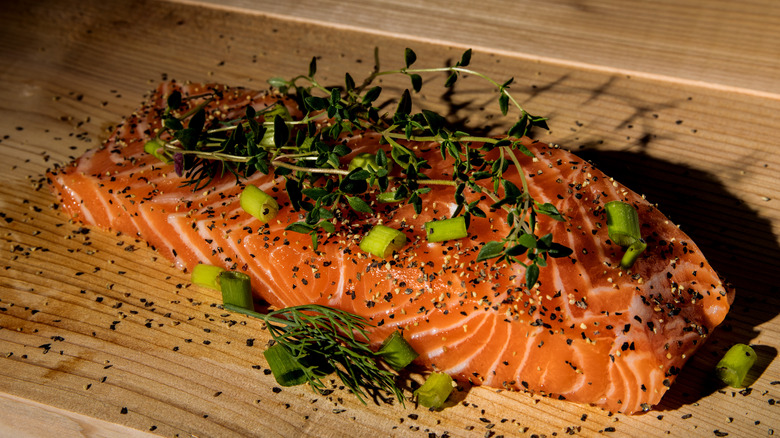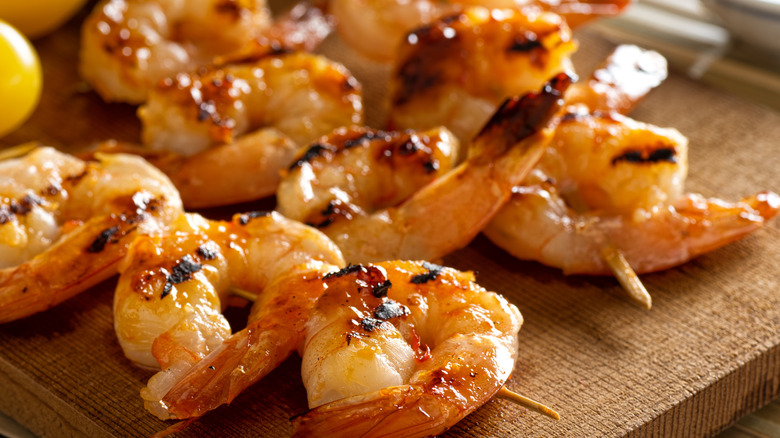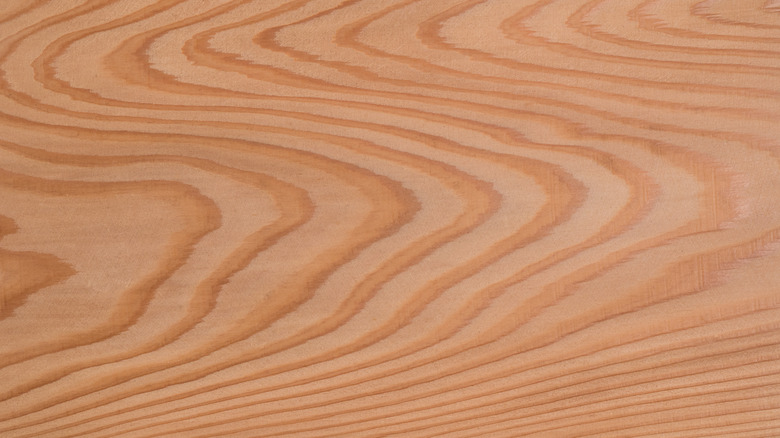Is A Cedar Plank Safe To Use In The Oven?
Cedar plank cooking might seem trendy and relatively new, but culinary enthusiasts were sizzling up steaks and seafood on planks of wood from at least the early 20th century, according to NPR. That includes President Franklin D. Roosevelt who's said to have relished "planking" his salmon and drizzling it with a white sauce. But the actual story digs much deeper, with the custom thriving in American Indian communities centuries ago, particularly with fish such as salmon, whitefish, and shad. Traditional cedar bakes in the Pacific Northwest involved slow-cooking entire salmons over outdoor fires, splayed across wooden boards, explains Marzetti.
The technique is much simplified today, most commonly involving an outdoor grill rather than an open bonfire. Packaged food-grade cedar planks populate supermarkets, upscale kitchen stores, and countless online venues, making it easy to pile up seafood, meats, and vegetables for an earthy, smokey, flavor-infused platter of deliciousness. It happens to be healthy as well, as the flavor comes naturally from cedar and smoke, with little need for added oils or fats. WebMD shared how plank-grilled salmon can be easy to prepare and low in calories, saturated fats, sodium, and carbohydrates.
But what if grilling is not your thing, or it's rainy and cold outside? That's when your oven comes into play, giving rise to questions about the safety of cedar planking in indoor environments. You're certainly not the first to wonder whether wood-plank cooking can gravitate to your kitchen without resulting in a 9-1-1 fire department call.
Wood plank baking in traditional ovens
It appears to be a pretty universal consensus that wood-plank cooking works just fine in traditional indoor ovens. In fact, the wood is much less likely to catch fire without the flickering of flames from an outdoor grill, and it requires less soaking time, notes Wild Alaskan Company. While planks bound for the grill need to soak for at least an hour, the same planks need only a 15-minute water immersion prior to baking. It's important to fully submerge the wood in water to create the woodsy, aromatic steam that defines cedar-plank cooking. A soaked plank also helps retain moisture and keep foods from drying out. You can also experiment with other liquid soaks such as wine, cider, or fruit juices.
Many commercially available cedar cooking planks come with instructions, and many advise seasoning the wood with cooking oil before using it the first time. Wild Alaskan simplifies the concept by suggesting a simple coating of oil directly on the plank before adding your food. Temperatures are more controllable in an oven than on a grill. Wildwood Grilling recommends heat levels from 350 to 450 degrees F, depending on the recipe, and positioning the plank on the upper oven rack. Other tips include placing a baking sheet on the bottom rack to catch spills and crisping the meats, fish, or vegetables for a couple of minutes under the broiler before removing the plank.
Choosing cedar baking planks
Some food-grade wood board manufacturers distinguish between grilling planks and baking planks, but it's more common to find universal planks that work in both applications. High-quality boards can be reused as many as three times, per Wild Alaskan Company, so long as they're free from excessive charring and can be cleaned without soap, which could seep into the wood. Various kinds of wood are available for planking, including alder and oak, but cedar is the gold standard for most chefs. Wildwood Grilling recommends using western red cedar for its smoky flavor, aroma, and non-toxic properties.
Commercially available cooking planks can be pricey, but the Seattle Times reveals a more cost-effective way to incorporate planking into your culinary world. Head to your local lumberyard and ask for an "untreated" cedar board, which will be free from chemicals that could enter your food. Aim for a thickness of at least ½-inch for stability. For greater longevity (multiple uses), choose something even thicker. Avoid boards with excessive knots that could trap hot oils during cooking.
You can ask the lumberyard to cut the board for you. In a YouTube video on how to make your own cedar planks for cooking, InnerBark Outdoors suggests purchasing a 4x4 piece of untreated cedar for about $15 to $20, which could yield up to 20 or 30 cedar plank cooking boards, depending on how you cut them.


